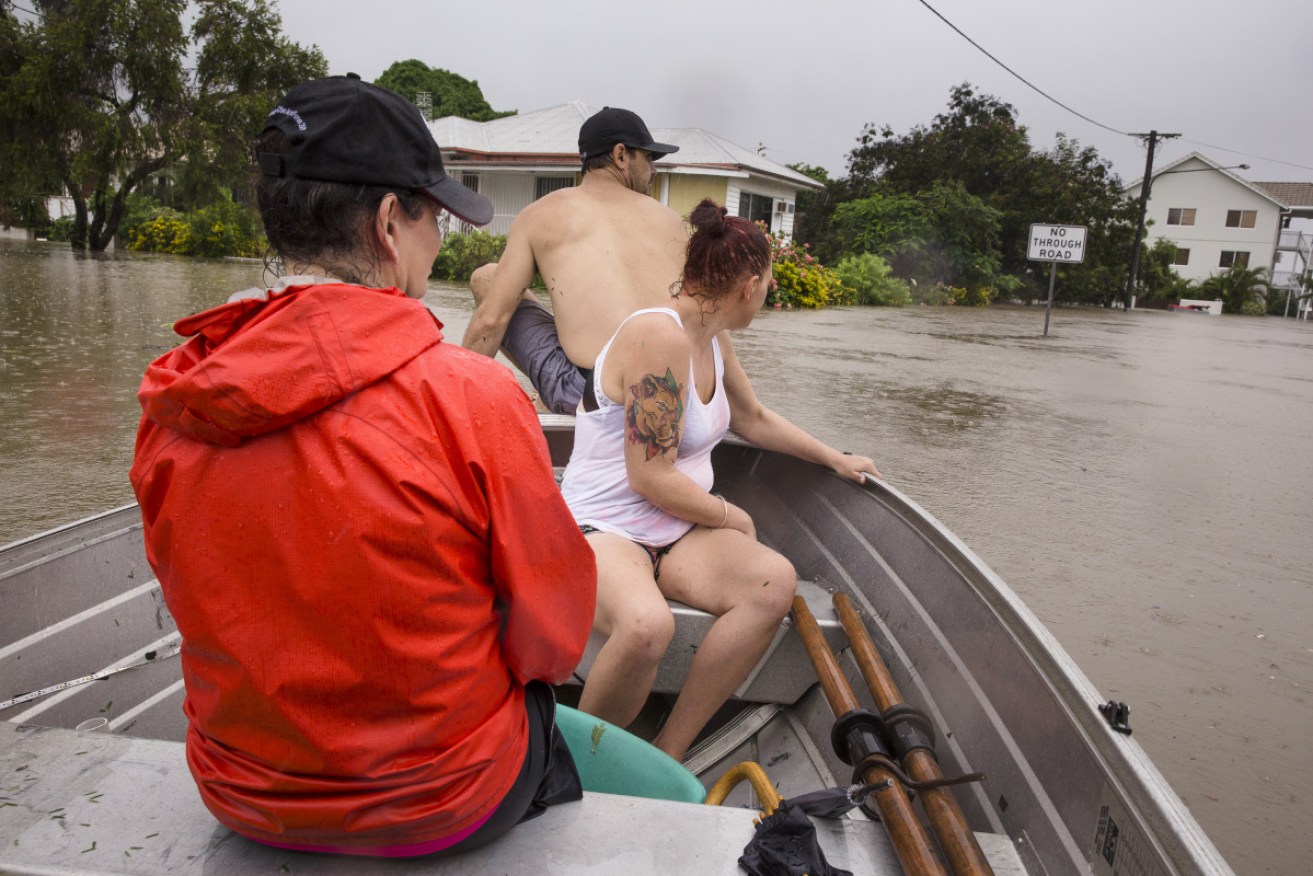‘Risk to life and property’: Townsville residents told to move to higher ground as dam gates open


Flooding in Rosslea, Townsville on Saturday February 2. Photo: AAP
Residents close to the Ross River in Townsville have been urged to move to higher ground, as flood waters continue to rise over the streets.
The Bureau of Meteorology warned about 6.10pm on Sunday of a “risk to life and property” and of dangerous and high-velocity flows occurring in the Ross River from 8.30pm until 6am on Monday.
“Unprecedented areas of flooding will occur in Townsville. Expect access routes to be cut,” the BoM warned.
“Conditions will change rapidly and continuously. Stay informed, look for updates and follow advice of emergency services.”
As an additional safety measure, Townsville Airport has been closed. All flights, inbound and outbound, have been cancelled until at least Monday morning.
To download a high-resolution PDF of Townsville City Council's map of properties that could potentially be inundated by flooding, click here: https://t.co/DatfuWYyvX #bigwet #alert pic.twitter.com/xHeWElavwx
— Queensland Police (@QldPolice) February 3, 2019
Residents in many suburbs were warned that they may experience flooding from rapid rises of the Ross River.
They include Rosslea, Hermit Park, Railway Estate, Townsville City, Oonoonba, Idalia, Cluden, West End, Rowes Bay, Garbutt, Aitkenvale, Cranbrook, Currajong, Mysterton, Pimlico, Mundingburra, Douglas, Annandale, Kirwan and Thuringowa Central and South Townsville areas.
“Everyone in the above suburbs should ensure they move away from riverbanks and get to higher ground before 8.30pm Sunday night. Residents still in their homes in these suburbs should move to the highest ground in their dwelling before 8.30pm Sunday night,” the BoM warned.
The latest warning comes as it emerged that the gates at the city’s overflowing dam would be opened at 8.30pm, releasing water at a rate of 2000 cubic metres per second.
This is 10 times the volume of water that has been released in the past few days after Townsville’s mayor Jenny Hill on Saturday night has rushed to assure residents that their city’s overflowing dam is safe.
Late on Saturday night, 500 homes were at risk of going under in Townsville, with tens of thousands more properties at risk if the north Queensland flood crisis worsens as expected.
“If the rain continues overnight and into tomorrow, if we keep going the way we are today, we are talking about 10,000 to 20,000 homes,” Chief Superintendent Steve Munro told reporters at a briefing late on Saturday evening.
North Queensland residents are hoping and praying their homes remain safe from flooding during what meteorologists are calling a one-in-100 year downpour.
More than the annual rainfall has fallen on parts of north Queensland in the past week, creating an officially declared disaster area stretching 700 kilometres along the coast from Cairns to Mackay and 900 kilometres inland to Mount Isa.
As of Sunday afternoon rainfall had broken the town’s seven-day record, set way back in 1998, when 886mm was recorded. So far this week’s reading stands at 1012mm and still climbing.
Queensland authorities say the state’s north has entered “unprecedented territory” as the natural disaster entered its fourth day.
I couldn’t be more proud of our soldiers’ efforts out there with @QldPolice and QFES today. #courage #initiative stay strong @Townsville pic.twitter.com/eO2Jqzy0up
— Brigadier Dave McCammon (@3BrigadeTSV) February 2, 2019
Police, soldiers and emergency services spent Saturday door-knocking in Townsville to warn residents who have been advised to watch out for updates on the disaster.
The monsoonal deluge has been declared a catastrophe by the Insurance Council of Australia, with losses estimated at $16.7 million and the worst yet to come.
Disaster assistance has been extended for communities in Townsville, Charters Towers, Palm Island, Richmond and Burdekin, the Queensland government announced on Saturday night.
It will be delivered through the jointly funded Commonwealth-Queensland Disaster Recovery Funding Arrangements.
About 100 homes were evacuated near the bulging Ross River dam as water was released, but it was back up to 216 per cent capacity by Saturday evening.
Paul Shafer and his family lost two cars, a truck and a caravan when water was released from the dam, a risky move designed to spare the town from more widespread flooding.
He understood the decision but said it was demoralising to see the destruction at his Hermit Park home.
Hermit Park Townsville. @abcnews @abcbrisbane pic.twitter.com/hGFxgND8DP
— Stephen Cavenagh ACS (@stevecav1) February 3, 2019
Ms Hill has said there was “no risk” to the integrity of the dam, constructed in 1971 and extended in 2007 when the wall was raised.
But hydro engineers have cautioned no dam can be declared absolutely flood-proof, describing the decision to repeatedly open the dam’s three floodgates as “delicate”.
“We took a deliberate decision to allow more water to exit the dam,” Cr Hill said on Saturday.
“It’s now running at approximately 872 cubic metres a second.
“That has given us a bit of spare capacity now in terms of the flood mitigation that the dam can provide.”
Queensland Fire and Emergency Services Assistant Commissioner Andrew Short told The New Daily there had been false rumours of the dam’s purportedly challenged integrity.
“Dams operate like this and it’s a normal cause of events and water is released where necessary,” he said, adding another release was due for Saturday night.
“Once in a lifetime spectacle,” say locals. Townsville’s Ross River Dam spilling in the #bigwet. @SBSNews pic.twitter.com/K5O4ryFVqf
— Stefan Armbruster (@StefArmbruster) February 2, 2019
Water engineers say you can’t flood-proof dams
Water and environment engineers have told The New Daily the dual function of dams like the Ross River – flood mitigation and water catchment – demand a delicate balancing act when deciding to open floodgates upstream of communities such as Townsville.
Following the Queensland floods of 2011, which claimed 33 lives, a subsequent inquiry, and relevant court cases ongoing, some experts declined to speak to the media due to political sensitivity.
Join me for the latest on the flood emergency in Townsville on Sky News today. 36k sandbags in use, army brought in to help residents downstream from the Ross River Dam. Dozens of homes inundated. More rain on the way @SkyNewsAust @carolinemarcus pic.twitter.com/4kP91XpjPm
— Ahron Young (@AhronYoung) February 1, 2019
Faith in the structural integrity of dams has also wavered after a collapsed at an iron ore mine in Brazil, leaving 348 people dead or missing, in late January.
University of Adelaide Professor Holger Maier, who researches water infrastructure, told The New Daily “you can never flood-proof” a dam.
Professor Maier said it was difficult to extrapolate the risk and probability of flood events because they are so relatively rare. He likened the daunting task of creating a dam-flood risk-assessment model to the difficulty of establishing mass public opinion from a survey sample of just five people.
“Every engineering structure is designed to fail at a certain probability with a cost and risk trade-off,” he said, adding that absolute safety doesn’t come cheap.
“Once you get to a certain risk level, the decision to risk-proof is doubling the cost.”

Floodwaters across Ross River in Townsville on Friday. Photo: AAP
The water engineer said it was also difficult for authorities to decide whether to “cause” a small flood downstream in preparation of possible damaging rainfall or drought.
“People would cry if you run out of water or when you make sure everyone is protected and don’t put people at risk,” Professor Maier said.
Record breaking floods expected
Queensland Premier Annastacia Palaszczuk said the monsoon had settled in over Queensland and the next 24 to 48 hours would be “crucial” on Friday afternoon.
“We have not been in this situation before. There has been a lot of rain falling over the Townsville catchment and some of these levels are unprecedented,” the Premier said.
Bureau of Meteorology Queensland manager Bruce Gunn said the slow-moving monsoonal trough would remain over northern Queensland for the next 48 hours.
“The risk is high for the next couple of days. We expect the peak in the rainfall to recur tonight (Saturday) and continue into next week,” Mr Gunn said.
The weather bureau has projected possible falls of 150 to 200 millimetres, with isolated events up to 300 millimetres in a six-hour period.
“The trough is slow moving and that’s why we’re getting such bigger accumulations of rainfall, so the risk is high for the next couple of days,” Mr Gunn said.








